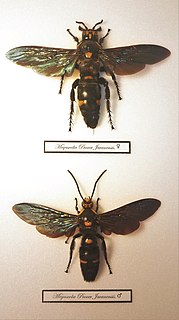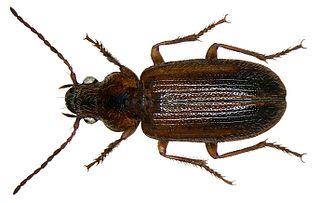Related Research Articles

Beetles are a group of insects that form the order Coleoptera, in the superorder Endopterygota. Their front pair of wings are hardened into wing-cases, elytra, distinguishing them from most other insects. The Coleoptera, with about 400,000 species, is the largest of all orders, constituting almost 40% of described insects and 25% of all known animal life-forms; new species are discovered frequently. The largest of all families, the Curculionidae (weevils), with some 83,000 member species, belongs to this order. Found in almost every habitat except the sea and the polar regions, they interact with their ecosystems in several ways: beetles often feed on plants and fungi, break down animal and plant debris, and eat other invertebrates. Some species are serious agricultural pests, such as the Colorado potato beetle, while others such as Coccinellidae eat aphids, scale insects, thrips, and other plant-sucking insects that damage crops.

In evolutionary ecology, a parasitoid is an organism that lives in close association with its host at the host's expense, eventually resulting in the death of the host. Parasitoidism is one of six major evolutionary strategies within parasitism, distinguished by the fatal prognosis for the host, which makes the strategy close to predation.

Potter wasps, the Eumeninae, are a cosmopolitan wasp group presently treated as a subfamily of Vespidae, but sometimes recognized in the past as a separate family, Eumenidae.

Sociality is the degree to which individuals in an animal population tend to associate in social groups (gregariousness) and form cooperative societies.

Scolt Head Island is an offshore barrier island between Brancaster and Wells-next-the-Sea in north Norfolk. It is in the parish of Burnham Norton and is accessed by a seasonal ferry from the village of Overy Staithe. The shingle and sand island appears to have originated from a former spit extending from the coast, and longshore drift means that it is slowly moving to the west and inshore.

A wasp is any insect of the narrow-waisted suborder Apocrita of the order Hymenoptera which is neither a bee nor an ant; this excludes the broad-waisted sawflies (Symphyta), which look somewhat like wasps but are in a separate suborder. The wasps do not constitute a clade, a complete natural group with a single ancestor, as their common ancestor is shared by bees and ants. Many wasps, those in the clade Aculeata, can sting their insect prey.

Megascolia procer is a solitary wasp in the family Scoliidae. Found in the Indonesian islands of Sumatra and Java, it is one of the largest wasps in the world, with a wingspan of 11.6 cm.

Dicheirotrichus gustavi is a ground beetle which emerges from cracks or holes to feed on tidal salt marshes after dusk. Despite living in a coastal environment, it has no cycle of behaviour linked to the tides, simply scurrying for dry land when caught by the approaching sea. It will eat the larvae of another intertidal beetle, Bledius spectabilis, if they are left unprotected by the adult.
Bledius spectabilis, commonly known as the magnificent salt beetle, is a species of small rove beetle.
The Scolebythidae are a small family of aculeate wasps in the superfamily Chrysidoidea. These chrysidoid wasps are found in Africa, Australia, the Neotropics, north China, Thailand and Fiji. They are parasites on larvae of Cerambycidae and Ptinidae.

Guyanemorpha is a genus of beetles, the Guyane False-form beetles, in the family Carabidae. It contains one known species, the Spectacular Guyane False-form beetle,, which was found in French Guiana and first described in 2013 by Terry L. Erwin in the open access journal ZooKeys. It was discovered during a survey of the country's insects by the Entomological Society Antilles-Guyane (SEAG).
Dinocampus coccinellae paralysis virus (DcPV) is a single-stranded, positive-sense RNA virus of insects, in the picorna-like virus family Iflaviridae, which was first characterised in 2015. It asymptomatically infects the parasitic braconid wasp, Dinocampus coccinellae, and has been proposed to be associated with the paralytic effect the wasp has on its host, the spotted lady beetle, Coleomegilla maculata, which it turns into a so-called "zombie bodyguard" for its pupa.
B. spectabilis may refer to:
Bledius annularis, or ringed borrow rove beetle, is a species of spiny-legged rove beetle in the family Staphylinidae. It is found in North America.

Bledius is a genus of spiny-legged rove beetles in the family Staphylinidae. There are at least 100 described species in Bledius.

Bledius mandibularis is a species of spiny-legged rove beetle in the family Staphylinidae. It is found in the Caribbean Sea and North America.
Bledius analis is a species of spiny-legged rove beetle in the family Staphylinidae. It is found in North America.
Bledius fenyesi is a species of spiny-legged rove beetle in the family Staphylinidae. It is found in Central America and North America.
Tristram Dick Wyatt is a British evolutionary biologist and author. He is a senior research fellow in the Department of Zoology, University of Oxford and an emeritus fellow of Kellogg College, Oxford. Wyatt researches pheromones and animal behavior.
References
- ↑ Wyatt, T D; Foster, W A (1989). "Parental Care in the Subsocial Intertidal Beetle, Bledius spectabilis, in Relation to Parasitism by the Ichneumonid Wasp, Barycnemis blediator". Behaviour. 110 (1–4): 76–92. doi:10.1163/156853989x00394.
| This Ichneumonidae-related article is a stub. You can help Wikipedia by expanding it. |